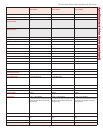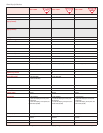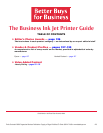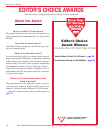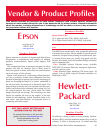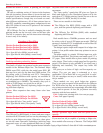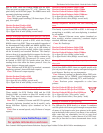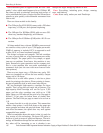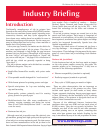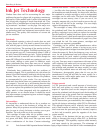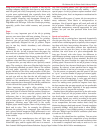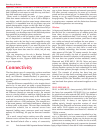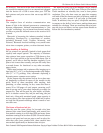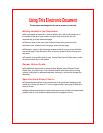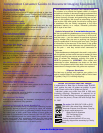
134
Entire Contents © 2006 Prog
ressiv
e Business Pub
lications
.
Copying of Pages Prohibited.To Order: 800 247 2185 or www.betterbuys.com
experience, however, we find that it is hard to get users to
select printing modes in a real office situation. You may
f
ind it difficult to train users to work this way, and there-
fore draft mode may rarely get used.
Photo mode is available on most of these printers.
Often that means resolution of up to 2,400 x 600dpi or
even higher, and this involves some image enhancement
software. It is remarkable how ink jet printers can print
superb photographic output on the right kind of paper.
Be aware, however, that photo mode slows down ink jet
printers to a crawl. If you need this capability more than
occasionally, you should get one of the dedicated printers
that specialize in printing at photo resolution.
The bottom line on ink jet speeds is that a good meas-
ure of skepticism is warranted. Ink jets are a lot faster
than they used to be, but they’re not comparable to color
laser printers, even those older models with similar offi-
cial page-per-minute speeds. If you need 20 prints of the
same page and you’re in a hurry, or you need to print a
50-page report more than once in a while, ink jets may
not be suitable
.
The one exception to this rule is Hewlett Packard’s
Officejet Pro series. These run at high quality in speeds
up to 10ppm in color, 12ppm in black-and-white, which
is quite r
especta
ble.
Connectivity
The three basic types of connectivity on these machines
are parallel (the old standard), USB (the current stan-
dard),
and Ethernet. Hewlett-Packard, in particular, is
providing wireless connectivity for an increasing number
of units.
Note that Ethernet compatibility is a lot simpler than it
used to be. At one point, we made a strong distinction
between those printers that had built-in Ethernet (that is,
thr
ough a car
d or board inside the computer) and exter-
nal Ether
net (through an external server). An external
server is a device (usually a small box slightly larger than
a deck of cards) that connects easily to the Ethernet net-
work and is connected to the printer in turn, using either
a par
allel ca
b
le or a USB connection.
The external serv-
er has some memory and limited intelligence, allowing it
to direct traffic to the printer. This once was considered a
second-class solution, but as external servers have
improved (adding more processor speed and internal
memory for buffering), the gap has narrowed consider-
a
b
ly.
As a result, several major vendors now offer external
Ether
net ser
v
er ad
d-ons tha
t ar
e as f
ast as their inter
nal
ones. Hewlett-Packard offers a variety of connectivity
options in both laser and ink jet lines, often allowing the
user a choice between internal and external connectivity.
HP offers external connectivity for some of its lowest-
priced and least robust ink jets. As home-office users are
starting to set up small Ethernet networks, this trend
keeps growing. The upshot is that Ethernet compatibility
is growing more common and the distinctions between
the different approaches are narrowing.
Wireless
As laptop and handheld computers have grown in use, so
has the need for a convenient way of sending print jobs
from these devices to peripherals such as printers,
copiers, and multifunctionals. Until recently, every time
you wanted to print in a new location, you’d have to whip
out a cable and attach and configure the new printer —
not something you’d want to do to print one or two
pages. The ideal solution is transmitting data using wire-
less technology, so that you don’t have to mess with
cables. Wireless technology has become common in
other aspects of life (take TV remote controls, for exam-
ple). But until recently, the lack of agreed-on certified
standards has slowed its adoption in the printing world.
We now have two popular wireless standards, namely
Bluetooth and IEEE 802.11 (W
i-Fi).
More and more
printers are offering interfaces to one or both of these
technologies. Hewlett-Packard has been leading the way,
of
fering interface options f
or both technologies for both
ink jet and laser printers (through a variety of servers and
hubs). The triumph of wireless has been long pro-
claimed, but it is no
w finally reaching critical mass, both
from the vendors of computers, handheld personal digi-
tal assistants (PDAs) like PalmPilot, and cell phones on
one hand and fr
om printer and netw
ork suppliers on the
other.
Wi-Fi (IEEE 802.11)
Wi-Fi, or IEEE 802.11 (more precisely, IEEE 802.11b or
the faster, but compatible, IEEE 802.11g), is a standard
f
or wir
eless local area networks (WLANs). This defines a
full Ethernet connection between devices and gives phys-
icall
y unconnected de
vices connecti
vity to the local ar
ea
network (LAN). In theory it can replace the office
cabling entirely, though up-to-date versions of wired
Ether
net (F
ast Ethernet) are far better suited to heavy net-
work traffic. Wi-Fi signals can go through walls, and
these wireless transmissions can extend to a distance of
100 feet or more.
Wi-Fi is generally used to connect a handheld or a lap-
top to a hub that is in turn connected to a traditional
wir
ed Ethernet backbone. In that way, the device can pig-
gyback onto an existing LAN. In order for this to work,
both ends of
the tr
ansaction need a tr
anscei
v
er (tr
ansmit
-
Better Buys for Business



